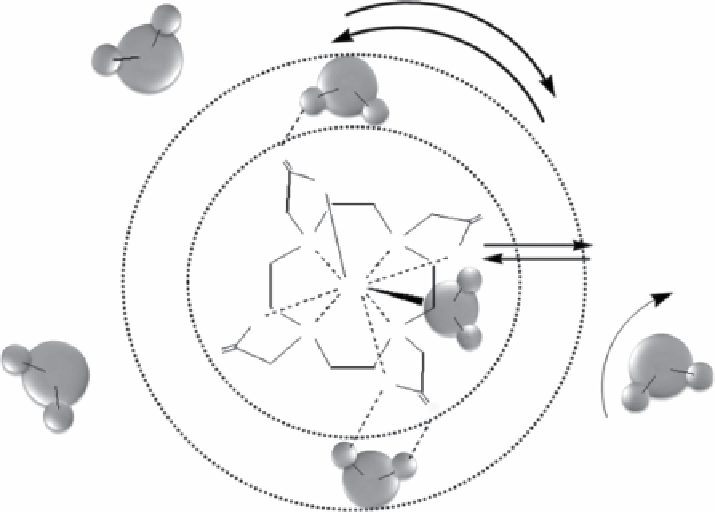Biomedical Engineering Reference
In-Depth Information
with
i
= 1 or 2 for longitudinal or transverse relaxation, respectively, 1/
T
i
,obs
the
observed relaxation rate, 1/
T
i
,d
the diamagnetic relaxation rate, and 1/
T
i
,p
the paramag-
netic relaxation rate.
r
i
is generally expressed in mM
−1
s
−1
. Relaxivity is governed by
a number of parameters described by the solomon-Bloembergen-Morgan (sBM)
theory [7].
The influence of a paramagnetic species on the proton nucleus of water decreases
with distance, and its effects on the relaxation can be distinguished according to three
relaxation spheres. The inner sphere corresponds to the water directly bound to the
paramagnetic metal, the second sphere corresponds to the water molecules bound to
the chelating agent-metal complex (by hydrogen bonds), and the outer sphere
describes the water from the bulk (Fig. 8.1). Because of water molecule exchanges
between the three spheres, the modification on the relaxation rate will not affect only
one water molecule, but it will be observed on a larger number of water molecules.
Relaxivity is governed by the residence time of the coordinated water molecule,
τ
m
;
the rotational tumbling time of the metal-water complex,
τ
r
; and the diffusional
correlation time,
τ
d
(Fig. 8.1).The first use of a CA for MRI was reported in 1978 by
Lauterbur
et al
. and involved a Mn
2+
salt [8]. With its seven unpaired 4f electrons, the
lanthanide ion Gd
3+
exhibits excellent characteristics and has rapidly become the
most widely used CA in MRI. Furthermore, the symmetric electronic state of Gd
3+
(
8
s
7/2
ground state) plays an important part in its efficiency, increasing the longitudinal
and transverse relaxation rate without shifting the proton resonance frequency.
H
τ
r
O
H
O
H
H
O
Bulk
water
O
O
N
N
τ
m
O
H
Gd
O
O
N
N
H
O
H
O
O
H
O
H
O
H
τ
D
H
H
O
FIGuRe 8.1
Representation of the inner sphere, the second sphere, and the outer relaxation
sphere.

Search WWH ::

Custom Search